
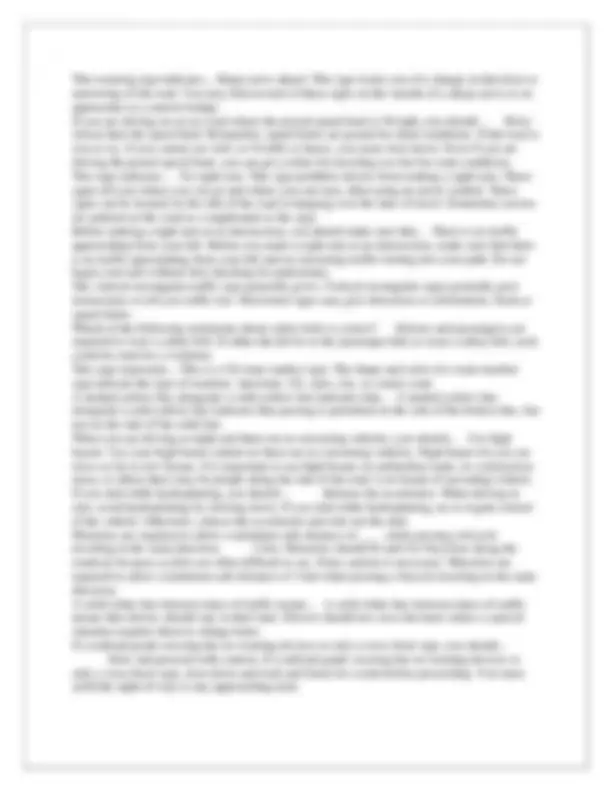
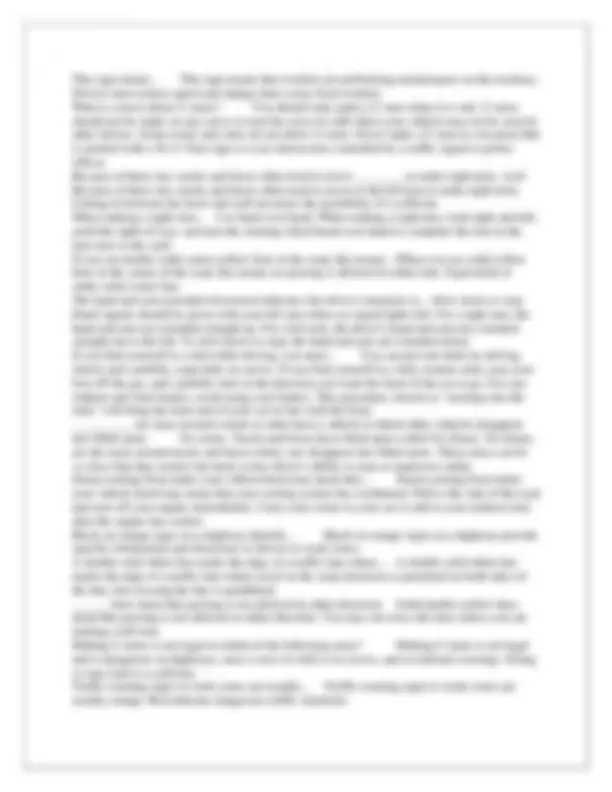
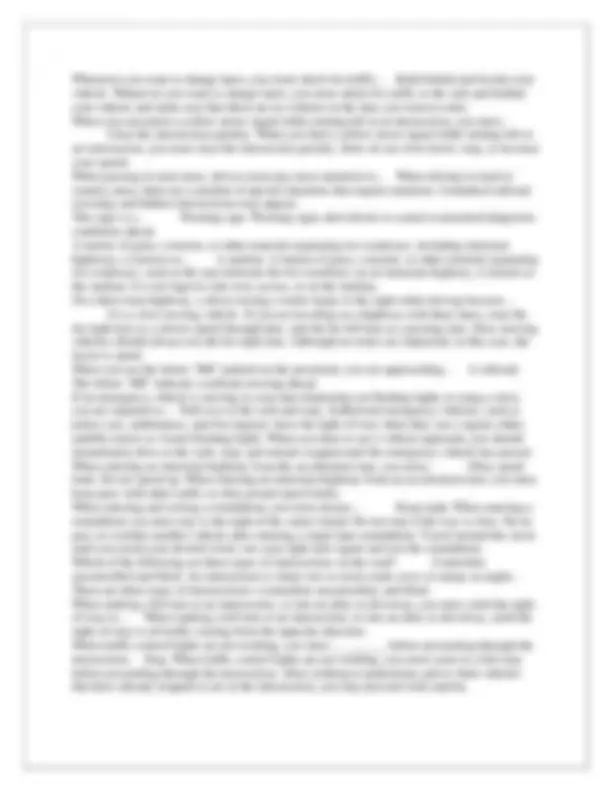
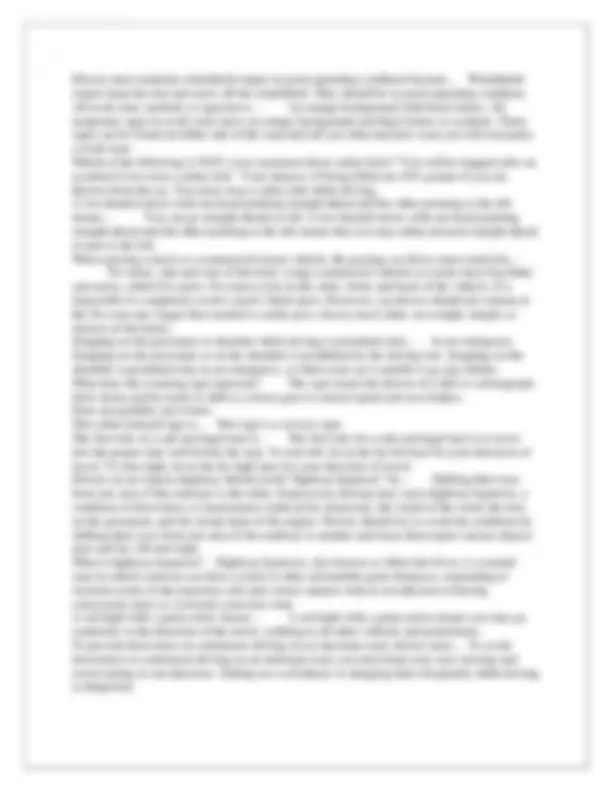
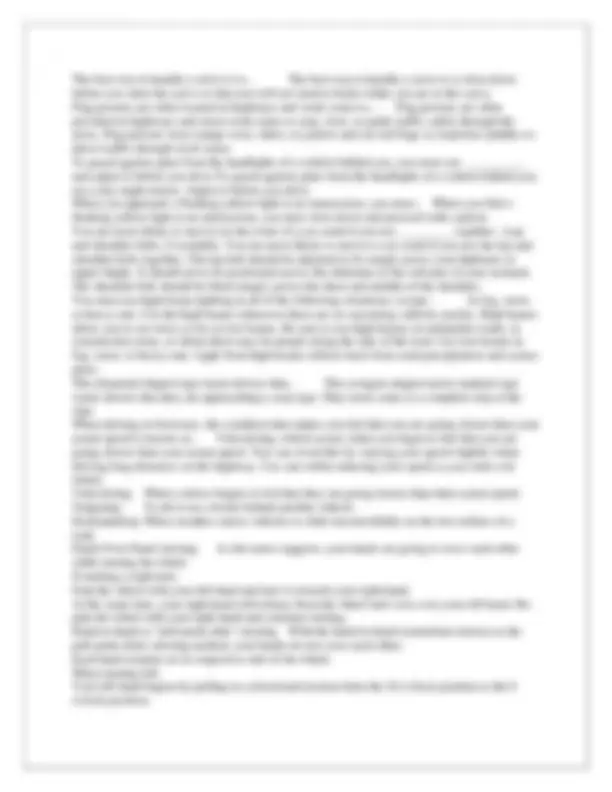
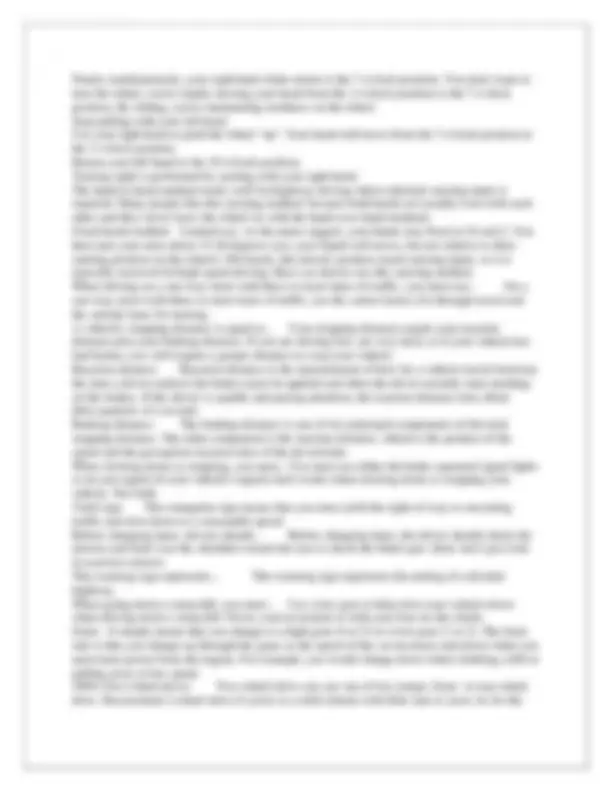
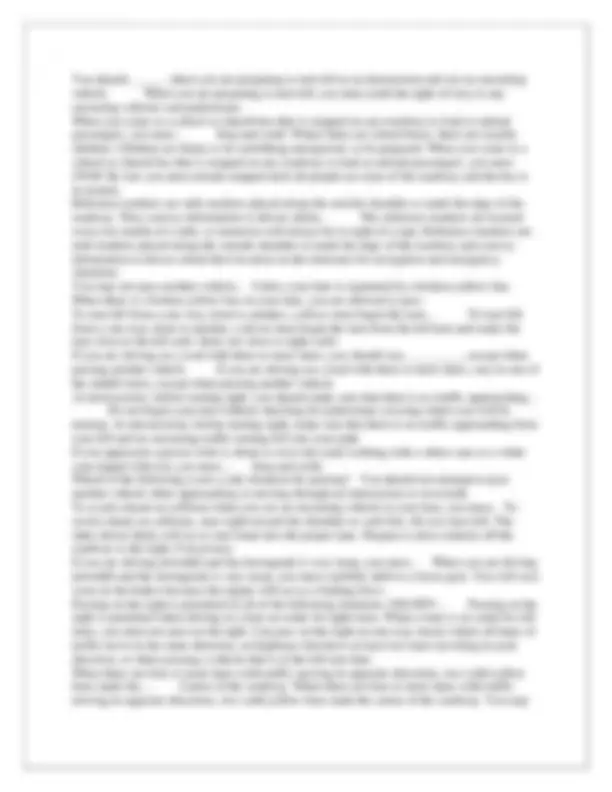
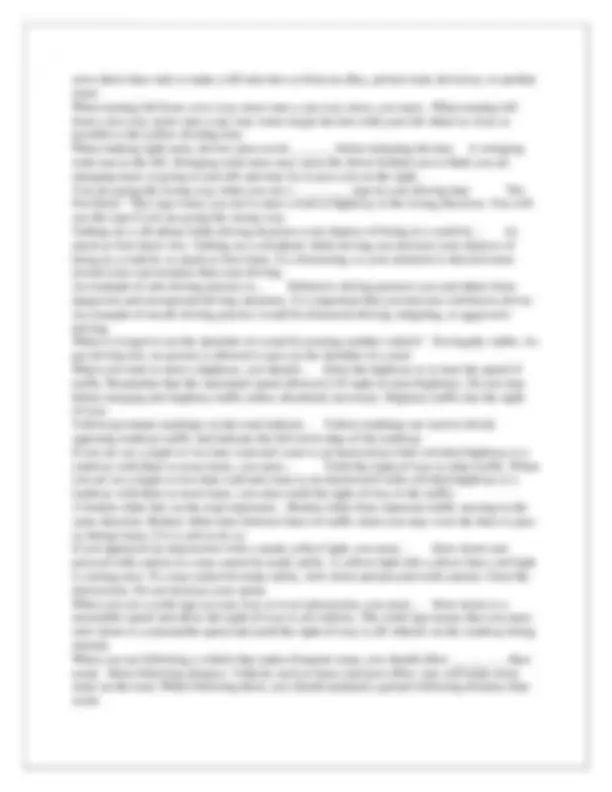
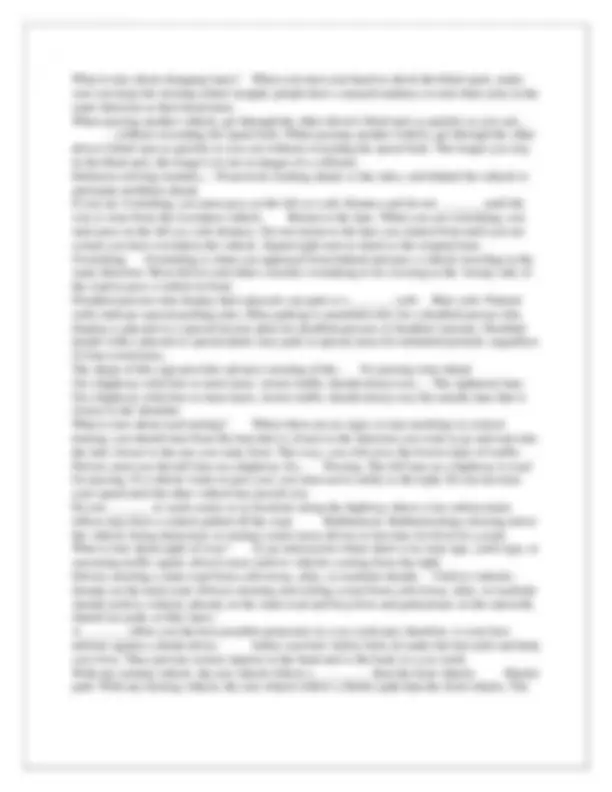
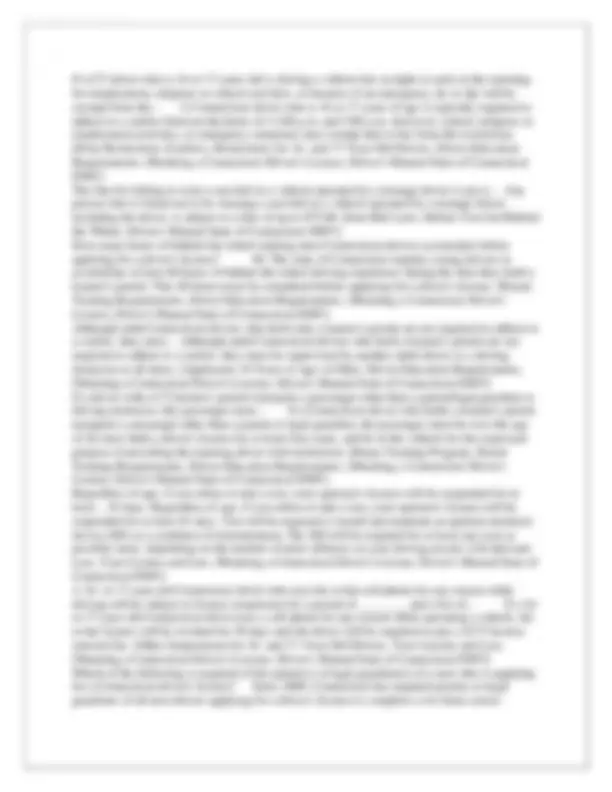
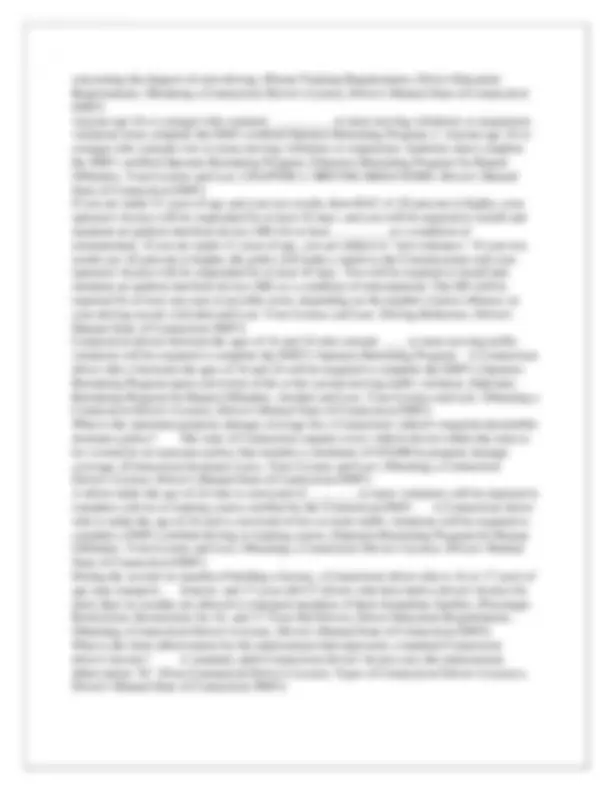
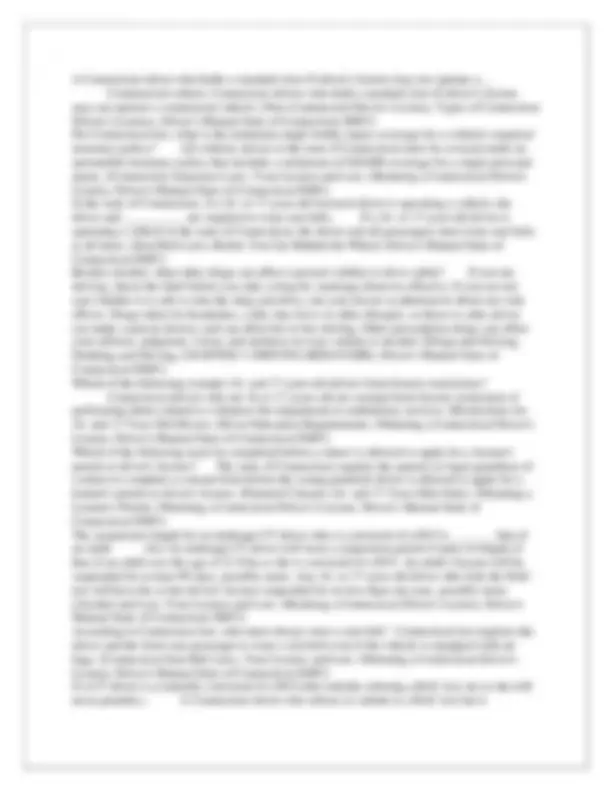
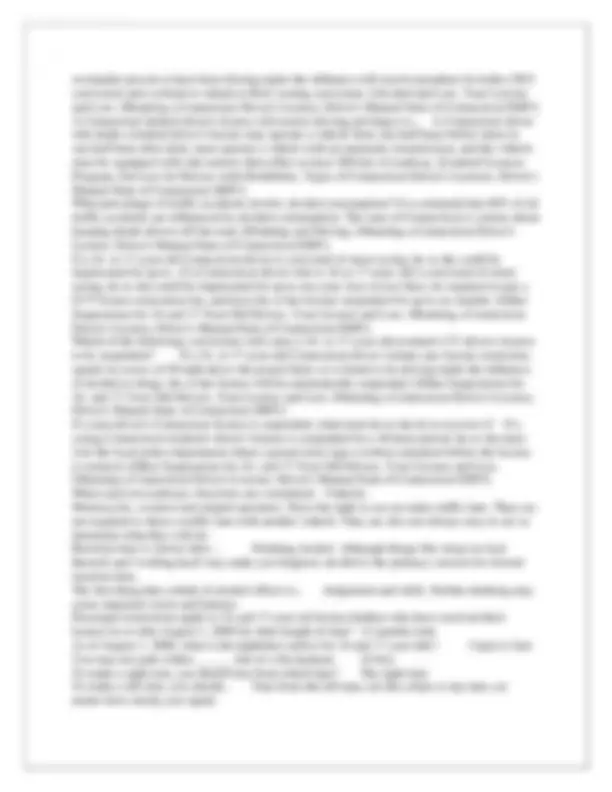
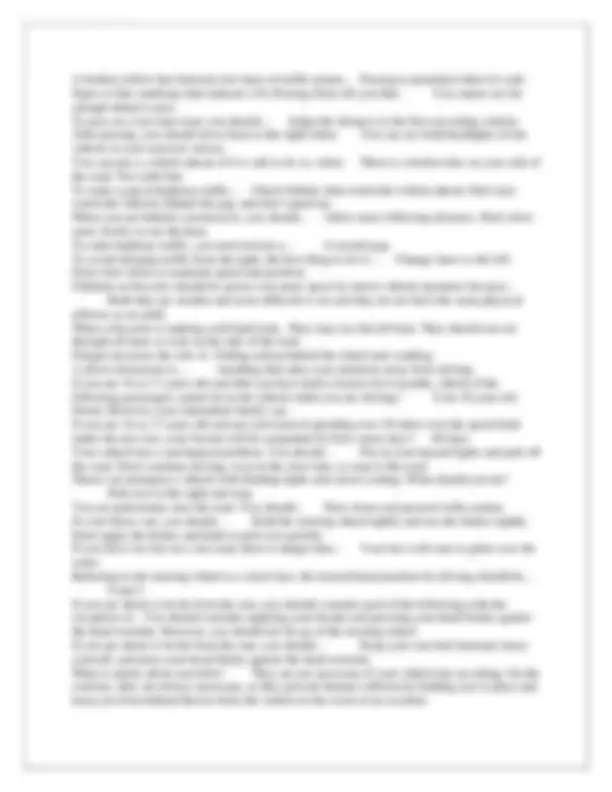
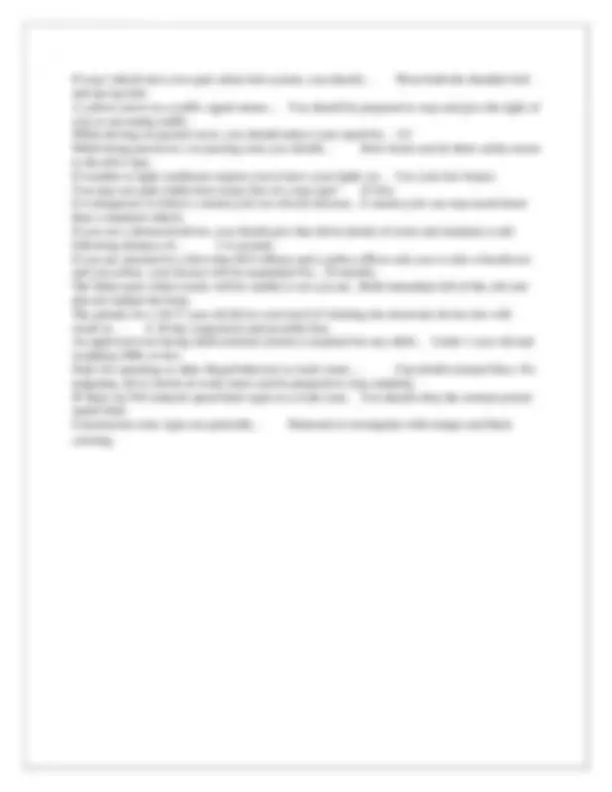
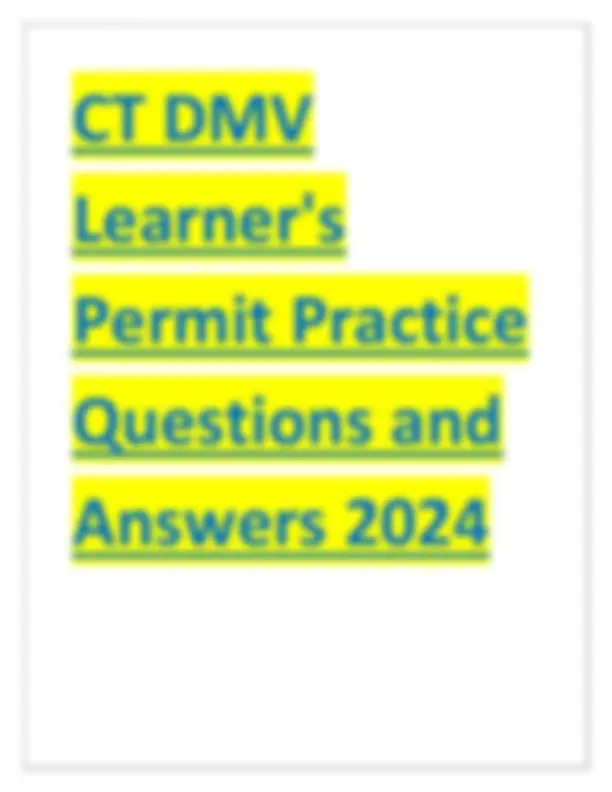


Study with the several resources on Docsity

Earn points by helping other students or get them with a premium plan


Prepare for your exams
Study with the several resources on Docsity

Earn points to download
Earn points by helping other students or get them with a premium plan
Community
Ask the community for help and clear up your study doubts
Discover the best universities in your country according to Docsity users
Free resources
Download our free guides on studying techniques, anxiety management strategies, and thesis advice from Docsity tutors
CT DMV Learner's Permit Practice Questions and Answers 2024
Typology: Exams
1 / 24

This page cannot be seen from the preview
Don't miss anything!

















What should you do if you approach a horse being ridden on the highway? Slow down. (hint: do not flash lights or blow the car horn) A flashing yellow traffic light means: Slow down and proceed with caution (hint: not stop entirely) During heavy traffic, drivers are prohibited from entering any intersection, unless there is sufficient space on the opposite side of the intersection to accommodate their vehicle without obstructing the passage of other vehicles or pedestrians. NOT doing so is referred to as... "Blocking the box." This road sign generally means... The road ahead curves to the right, then the left. (hint: not right and left turns ahead, depicts actual direction, also does not indicate a winding road or simply a right turn.) This road sign indicates... Crossroads. If your driver's license says you must wear corrective lenses and you are stopped by a law enforcement officer while not wearing them, you may be... Issued a citation. A new driver's license is valid for 5-1/2 to 7 years and will expire... On the driver's birthday of the last year. Know these... Signs. Some flash cards dedicated to signs but not all. A 16- or 17-year-old driver who received their license on or after August 1, 2008, must not operate a vehicle between the hours of ________, unless it is for certain activities. 11pm to 5am. When driving a vehicle, unbalanced tires and low tire pressure can cause.... Faster tire wear. If you fail the Blood Alcohol Content (BAC) test, your operator's license will be suspended for at least... 45 days. If it feels like your tires have lost traction with the surface of the road, you should... Not stop until the tires are gripping the road again, keep steering the wheel straight and ease your foot off the gas pedal. Which of the following statements is true regarding the use of a cell phone while driving for 16- 17 year old drivers? Prohibited. Phone should be kept in glove compartment. Which of the following statements is true regarding the use of a cell phone while driving for adult drivers? Hands free cell phone use. When a road is too narrow for cars and bikes to ride side-by-side, bicyclists should... Ride near or in the center of the lane. Bicyclists have the right. The correct hand signal indicating a right turn is... Extending the arm and hand upwards. Which of the following right-of-way rules is not true? At an intersection where there is no stop sign, yield sign, or oncoming traffic signal, drivers must yield to vehicles coming from the right. Right of way ALWAYS goes to pedestrians. When turning sharp corners, turn the steering wheel using the... When turning sharp corners, turn the steering wheel using the "hand-over-hand" technique. When you complete a turn, straighten out the steering wheel by hand. Letting it slip through your fingers could be dangerous. Which of the following statements is NOT correct when making a turn? Do not signal when no one is around.
Correct when making a turn: If you intend to turn after an intersection, wait until you reach the intersection before signaling. Signal at least three seconds before turning. If your turn signals are not working, use hand signs. Safer drivers tend to look at least _________ ahead of their vehicles. Safer drivers tend to look at least 12 seconds ahead of their vehicles. This is the distance that a vehicle will travel in 12 seconds. In the city, 12 seconds is about one block. When you drive in city traffic, you should try to look at least one block ahead. On the highway, 12 seconds is about four city blocks (or a quarter of a mile). Blind pedestrians may carry _________ canes or use the assistance of guide dogs. White canes. You must not park your vehicle... Do not park within 25 feet of a pedestrian safety zone or within 25 feet of a stop sign. The eye test for the driver's license evaluates... The eye test evaluates: 1) acuity—how clearly you see; 2) peripheral vision—how far you can see to either side while looking straight ahead; 3) depth and color perception. If your brakes stop working while driving, which of the following must be done? If your brakes stop working: 1) Pump the brake pedal several times. This will often build up enough brake pressure to allow you to stop. 2) If that does not work, use the parking brake. Pull on the parking brake handle slowly so you will not lock the rear wheels and cause a skid. Be ready to release the brake if the vehicle does start to skid. 3) If that does not work, start shifting to lower gears and look for a safe place to slow to a stop. Make sure the vehicle is off the roadway. Do not drive the vehicle without brakes. When a vehicle does not pass an emissions inspection, the driver will be given ________ to have the problem fixed and the emissions re-checked. Your vehicle may be required to have an emissions inspection at an authorized inspection station. If the vehicle does not pass, you will be given 60 days to have the problem fixed and the emissions re-checked. (2 months) When you are being followed too closely, you should... If you are being followed closely, pull to the right and allow the vehicle behind you to pass. This sign indicates... This sign indicates that the pavement is wet. When pavement is wet, drivers should reduce their speed. Vehicles should not be parked within _________ of a fire hydrant. 10 feet. 25 feet from a pedestrian safety zone. 25 feet from a stop sign. At a speed of 55 mph, a vehicle needs _________ to pass. At a speed of 55 mph, a vehicle needs about 10 seconds to pass. That means a driver needs a 10-second opening in oncoming traffic and sight distance to pass. When you see or hear an emergency vehicle approaching from any direction, you must... When you see or hear an emergency vehicle approaching from any direction, you must pull over to the right edge of the road, or as near to the right as possible, and stop your vehicle. You must remain stopped until the emergency vehicle has passed, unless otherwise directed by a state/local police officer or a firefighter. These lines indicate... These center lanes are reserved for making left turns (or U-turns, when they are permitted), but can be used by vehicles traveling in both directions. On the pavement, left-turn arrows for traffic in one direction alternate with left-turn arrows for traffic coming from the other direction. These lanes are marked on each side by solid and dashed yellow lines.
This sign means... This sign means that workers are performing maintenance on the roadway. Drivers must reduce speed and change lanes away from workers. What is correct about U-turns? You should only make a U-turn when it is safe. U-turns should not be made on any curve or near the crest of a hill when your vehicle may not be seen by other drivers. Some towns and cities do not allow U-turns. Never make a U-turn at a location that is marked with a No U-Turn sign or at an intersection controlled by a traffic signal or police officer. Because of their size, trucks and buses often need to move ________ to make right turns. Left. Because of their size, trucks and buses often need to move to the left lane to make right turns. Cutting in between the truck and curb increases the possibility of a collision. When making a right turn... Use hand over hand. When making a right turn, look right and left, yield the right-of-way, and turn the steering wheel hand-over-hand to complete the turn in the lane next to the curb. If you see double solid center yellow lines in the road, this means... When you see solid yellow lines in the center of the road, this means no passing is allowed in either lane. Equivalent of white solid center line. The hand and arm extended downward indicates the driver's intention to... Slow down or stop. Hand signals should be given with your left arm when car signal lights fail. For a right turn, the hand and arm are extended straight up. For a left turn, the driver's hand and arm are extended straight out to the left. To slow down or stop, the hand and arm are extended down. If you find yourself in a skid while driving, you must... You can prevent skids by driving slowly and carefully, especially on curves. If you find yourself in a skid, remain calm, ease your foot off the gas, and carefully steer in the direction you want the front of the car to go. For cars without anti-lock brakes, avoid using your brakes. This procedure, known as "steering into the skid," will bring the back end of your car in line with the front. __________ are areas around a truck or other heavy vehicle in which other vehicles disappear into blind spots. No-zones. Trucks and buses have blind spots called No-Zones. No-Zones are the areas around trucks and buses where cars disappear into blind spots. These areas can be so close that they restrict the truck or bus driver's ability to stop or maneuver safely. Steam coming from under your vehicle hood may mean that... Steam coming from under your vehicle hood may mean that your cooling system has overheated. Pull to the side of the road and turn off your engine immediately. Carry extra water in your car to add to your radiator only after the engine has cooled. Black on orange signs on a highway identify... Black on orange signs on a highway provide specific information and directions to drivers in work zones. A double solid white line marks the edge of a traffic lane where... A double solid white line marks the edge of a traffic lane where travel in the same direction is permitted on both sides of the line, but crossing the line is prohibited. ______ lines mean that passing is not allowed in either direction. Solid double yellow lines mean that passing is not allowed in either direction. You may not cross the lines unless you are making a left turn. Making U-turns is not legal in which of the following areas? Making U-turns is not legal and is dangerous on highways, near a crest of a hill or in curves, and at railroad crossings. Doing so may lead to a collision. Traffic warning signs in work zones are usually... Traffic warning signs in work zones are usually orange. Red indicates dangerous traffic situations.
Whenever you want to change lanes, you must check for traffic... Both behind and beside your vehicle. Whenever you want to change lanes, you must check for traffic to the side and behind your vehicle and make sure that there are no vehicles in the lane you want to enter. When you encounter a yellow arrow signal while turning left at an intersection, you must... Clear the intersection quickly. When you find a yellow arrow signal while turning left at an intersection, you must clear the intersection quickly. (hint: do not slow down, stop, or increase your speed) When passing in rural areas, drivers must pay more attention to... When driving in rural or country areas, there are a number of special situations that require attention. Unmarked railroad crossings and hidden intersections may appear. This sign is a... Warning sign. Warning signs alert drivers to actual or potential dangerous conditions ahead. A barrier of grass, concrete, or other material separating two roadways, including interstate highways, is known as... A median. A barrier of grass, concrete, or other material separating two roadways, such as the area between the two roadways on an interstate highway, is known as the median. It is not legal to ride over, across, or on the median. On a three-lane highway, a driver towing a trailer keeps to the right while driving because... It is a slow moving vehicle. If you are traveling on a highway with three lanes, treat the far right lane as a slower speed through lane, and the far left lane as a passing lane. Slow moving vehicles should always use the far right lane. Although no-zones are important, in this case, the factor is speed. When you see the letters "RR" painted on the pavement, you are approaching... A railroad. The letters "RR" indicate a railroad crossing ahead. If an emergency vehicle is moving in your lane displaying red flashing lights or using a siren, you are required to... Pull over to the curb and stop. Authorized emergency vehicles, such as police cars, ambulances, and fire engines, have the right-of-way when they use a signal, either audible (siren) or visual (flashing light). When you hear or see a vehicle approach, you should immediately drive to the curb, stop, and remain stopped until the emergency vehicle has passed. When entering an interstate highway from the acceleration lane, you must... Obey speed limit. Do not speed up. When entering an interstate highway from an acceleration lane, you must keep pace with other traffic or obey posted speed limits. When entering and exiting a roundabout, you must always... Keep right. When entering a roundabout you must stay to the right of the center island. Do not stop if the way is clear. Never pass or overtake another vehicle after entering a single lane roundabout. Travel around the circle until you reach your desired street; use your right-turn signal and exit the roundabout. Which of the following are three types of intersections on the road? Controlled, uncontrolled and blind. An intersection is where two or more roads cross or merge at angles. There are three types of intersections—controlled, uncontrolled, and blind. When making a left turn at an intersection, or into an alley or driveway, you must yield the right- of-way to... When making a left turn at an intersection, or into an alley or driveway, yield the right-of-way to all traffic coming from the opposite direction. When traffic control lights are not working, you must _________ before proceeding through the intersection. Stop. When traffic control lights are not working, you must come to a full stop before proceeding through the intersection. After yielding to pedestrians and to other vehicles that have already stopped or are in the intersection, you may proceed with caution.
confuse or frighten them. Use your horn sparingly—various kinds of violence begin with a driver honking their horn. A sign with an orange background and black letters indicates A construction zone sign. Construction signs are used to notify drivers of unusual or potentially dangerous conditions on or near the traveled way. All temporary signs in work zones have an orange background and black letters or symbols. Locked wheel skids are usually caused by... Braking too hard at a high speed. This type of skid is usually caused by braking too hard at a high speed and locking the wheels. The vehicle will skid no matter which way the steering wheel is turned. Take your foot off the brake to unlock the wheels. Then straighten the front wheels as the vehicle begins to straighten out. Slow the vehicle gradually until you are at a safe speed to continue driving. When entering a paved thoroughfare from a private road, a driveway, or an unpaved road, you must... If you are entering a paved thoroughfare from a private road, a driveway, or an unpaved road, you are required to stop your vehicle and then give the right-of-way to pedestrians and other vehicles. (hint: do not just slow down) If another driver is passing your vehicle, you must... When another driver is passing, you must stay in the lane and do not increase your speed. Allow the driver to pass safely. This numbered figure shows... This sign shows the clearance between the bridge and the road ahead. Vehicles more than the posted height cannot clear the bridge. If someone is following you too closely, you must... If someone is following you too closely (tailgating), you must slow down and encourage the driver behind you to pass and avoid being hit from behind. If your vehicle's wheels drift onto the shoulder of the road, you must... Slowly return to the pavement. If your vehicle's wheels drift onto the shoulder of the road, do not try to turn back onto the pavement right away. This might throw the vehicle off balance. You must try to slow down, regain control, and turn slowly onto the road. What is the shoulder of the road? A road shoulder is a strip of land immediately adjacent to the traffic lane of a road not bordered by kerb & channel. The shoulder may be sealed in the case of highways and major roads, but it is typically unsealed and of a lesser depth and perhaps constructed of inferior material than the adjacent traffic lane. Large electronic flashing arrow panels may be used in work zones day and night to... Guide drivers into certain traffic lanes. guide drivers into certain traffic lanes. Large electronic flashing arrow panels may be used in work zones day and night to guide drivers into certain traffic lanes. These are placed in the roadway or mounted on vehicles to advise approaching motorists of lane closures. Begin your merge well in advance of the sign. What is an interchange? In the field of road transport, an interchange is a road junction that typically uses grade separation, and one or more ramps, to permit traffic on at least one highway to pass through the junction without directly crossing any other traffic stream. What is true about interchanges? For all interchanges on expressways or interstate highways, you should use exit and entrance ramps, which are provided at the sides of the highways. Do not use median crossovers, as these are for authorized vehicles, such as emergency and maintenance vehicles. Do not make a U-turn on a curve or near the top of a hill if you cannot be seen by... Drivers approaching in either direction. Do not make a U-turn on a curve or near the top of a hill if you cannot be seen by other drivers approaching from either direction. Do not make a U-turn where signs prohibit doing so.
Drivers must maintain windshield wipers in good operating condition because... Windshield wipers keep the rain and snow off the windshield. They should be in good operating condition. All work zone symbols or signs have... An orange background with black letters. All temporary signs in work zones have an orange background and black letters or symbols. These signs can be found on either side of the road and tell you what and how soon you will encounter a work zone. Which of the following is NOT a true statement about safety belts? "You will be trapped after an accident if you wear a safety belt." Your chances of being killed are 25% greater if you are thrown from the car. You must wear a safety belt while driving. A two-headed arrow with one head pointing straight ahead and the other pointing to the left means... You can go straight ahead or left. A two-headed arrow with one head pointing straight ahead and the other pointing to the left means that you may either proceed straight ahead or turn to the left. When passing a truck or a commercial motor vehicle, the passing car driver must watch for... No zones, side and rear of the truck. Large commercial vehicles or trucks have big blind spot areas, called No-zones. No-zones exist on the sides, front, and back of the vehicle. It is impossible to completely avoid a truck's blind spots. However, car drivers should not remain in the No-zone any longer than needed to safely pass a heavy truck (hint: not weight, length, or mirrors of the truck). Stopping on the pavement or shoulder while driving is permitted only... In an emergency. Stopping on the pavement or on the shoulder is prohibited by the driving law. Stopping on the shoulder is permitted only in an emergency, or when your car is unable to go any farther. What does this warning sign represent? The sign warns the drivers of a hill or a downgrade. Slow down and be ready to shift to a lower gear to control speed and save brakes. Does not prohibit, just warns. This white lettered sign is... This sign is a service sign. The first rule of a safe and legal turn is... The first rule for a safe and legal turn is to move into the proper lane well before the turn. To turn left, be in the far left lane for your direction of travel. To turn right, be in the far right lane for your direction of travel. Drivers on an express highway should avoid "highway hypnosis" by... Shifting their eyes from one area of the roadway to the other. Expressway driving may cause highway hypnosis, a condition of drowsiness or unawareness induced by monotony, the sound of the wind, the tires on the pavement, and the steady hum of the engine. Drivers should try to avoid the condition by shifting their eyes from one area of the roadway to another and focus them upon various objects near and far, left and right. What is highway hypnosis? Highway hypnosis, also known as white line fever, is a mental state in which a person can drive a truck or other automobile great distances, responding to external events in the expected, safe and correct manner with no recollection of having consciously done so. Lowered conscious state. A red light with a green arrow means... A red light with a green arrow means you may go cautiously in the direction of the arrow, yielding to all other vehicles and pedestrians. To prevent drowsiness in continuous driving on an interstate road, drivers must... To avoid drowsiness in continuous driving on an interstate road, you must keep your eyes moving and avoid staring in one direction. Talking on a cell phone or changing lanes frequently while driving is dangerous.
Nearly simultaneously, your right hand slides down to the 7 o'clock position. You don't want to turn the wheel, you're simply moving your hand from the 2 o'clock position to the 7 o'clock position. By sliding, you're maintaining readiness on the wheel. Stop pulling with your left hand. Use your right hand to push the wheel "up". Your hand will move from the 7 o'clock position to the 2 o'clock position. Return your left hand to the 10 o'clock position. Turning right is performed by starting with your right hand. The hand-to-hand method works well for highway driving where minimal steering input is required. Many people like this steering method, because both hands are usually even with each other and they never leave the wheel (as with the hand-over-hand method). Fixed hands method Limited use. As the name suggest, your hands stay fixed at 10 and 2. You then turn your arms about 15-20 degrees (yes, your hands will move, but not relative to their starting position on the wheel). Obviously, this doesn't produce much steering input, so it is typically reserved for high-speed driving. Race car drivers use this steering method. When driving on a one-way street with three or more lanes of traffic, you must use... On a one-way street with three or more lanes of traffic, use the center lane(s) for through-travel and the outside lanes for turning. A vehicle's stopping distance is equal to... Your stopping distance equals your reaction distance plus your braking distance. If you are driving fast, are very tired, or if your vehicle has bad brakes, you will require a greater distance to stop your vehicle. Reaction distance Reaction distance is the measurement of how far a vehicle travels between the time a driver realizes the brakes must be applied and when the driver actually starts pushing on the brakes. If the driver is capable and paying attention, the reaction distance lasts about three-quarters of a second. Braking distance The braking distance is one of two principal components of the total stopping distance. The other component is the reaction distance, which is the product of the speed and the perception-reaction time of the driver/rider. When slowing down or stopping, you must...You must use either the brake-operated signal lights or an arm signal (if your vehicle's signals don't work) when slowing down or stopping your vehicle. Not both. Yield sign This triangular sign means that you must yield the right-of-way to oncoming traffic and slow down to a reasonable speed. Before changing lanes, drivers should... Before changing lanes, the driver should check the mirrors and look over the shoulder toward the rear to check the blind spot. (hint: don't just look in rearview mirror) This warning sign represents... This warning sign represents the ending of a divided highway. When going down a steep hill, you must... Use a low gear to help slow your vehicle down when driving down a steep hill. Never coast in neutral or with your foot on the clutch. Gears It simply means that you change to a high gear (4 or 5) or a low gear (1 or 2). The basic rule is that you change up through the gears as the speed of the car increases and down when you need more power from the engine. For example, you would change down when climbing a hill or pulling away at low speed. 2WD (Two wheel drive) Two-wheel drive cars use one of two setups: front- or rear-wheel drive. Recommend 2-wheel drive if you're in a mild climate with little rain or snow.As for the
difference between front- and rear-wheel drive, many drivers probably wouldn't notice a thing. But the general rule is that rear-wheel-drive cars are better for performance and worse in bad weather, while front-wheel drive offers improved harsh-weather driving. Front-wheel drive is also typically used in family cars with better fuel economy and less performance. 4WD (Four wheel drive) Four-wheel drive, meanwhile, is usually disengaged -- that is, until you flip a switch or pull a lever to engage it. Then all four wheels turn at the same time. But if you live in an area with muddy roads or heavy snow, you'll probably want to go with 4-wheel drive. All-wheel-drive vehicles tend to get stuck in such situations, because sensors have trouble determining exactly where to send power. Four-wheel-drive vehicles don't have that problem. AWD (All wheel drive) If you live in an area with occasional snow and rain, all-wheel drive is probably the right choice. Since you don't have to worry about driving through snow banks, leave the hard work to your car's computers. If they detect the car is sliding, they'll step in -- and you won't have to worry. All-wheel-drive systems are always on, and they use electronic sensors to determine which wheel should get a car's power. Which of the following statements is true in/near school zones? Drivers must always yield to pedestrians in school crosswalks. There may or may not be school crossing guards to assist with safe pedestrian crossing. Drivers must be aware that children are smaller and have minimal perception. Fines are doubled in/near school zones. If you are driving on a two-lane road, it is safest to drive your vehicle _________ your lane. It is safest to drive in the center of your lane. Keep as much space as you can between your vehicle and oncoming vehicles. This triangular sign indicates... Any slow-moving vehicle or equipment, animal-drawn vehicle, or road construction or maintenance machinery normally operating at or under 25 mph must display an emblem on the rear, as shown above, except for road construction or maintenance machinery engaged in actual construction or maintenance work and guarded by a flagger or warning signs. When is it legal to make a left turn at a red light? The following states and territories ban left turns on red: South Dakota (unless permitted by local ordinance), Connecticut, Maine, Mississippi, Missouri, New Hampshire, North Carolina, Rhode Island, and the District of Columbia. You may make a left turn at a red light if you are turning from the left lane of a one- way street onto another one-way street in other states. What do you do when your brakes fail? If your brakes fail, pump the brake pedal. Pumping might temporarily restore enough brake fluid pressure to slow or stop your vehicle. Downshift to a lower gear. This uses the braking power of the engine to slow your vehicle. As a last resort, rub the wheels against a curb to reduce speed. If a collision is unavoidable, steer for a sideswipe rather than colliding head-on into something solid. Vertical rectangular signs with black letters on a white background are used as... Vertical rectangular signs with black letters on a white background are used to regulate the traffic. Speed limit signs and "Do not pass" signs are some examples. Regulatory signs They are usually rectangular or square with a white or black background and black, white or coloured letters. A sign with a green circle means you may or must do the activity shown inside the ring. A red circle with a line through it means the activity shown is not allowed. Guide signs Guide signs provide directional and mileage information to specific destinations. They can be rectangular or have other shapes. Route signs mark federal interstates, state highways, and county or municipal roadways.
You should ______ when you are preparing to turn left at an intersection and see an oncoming vehicle. When you are preparing to turn left, you must yield the right-of-way to any oncoming vehicles and pedestrians. When you come to a school or church bus that is stopped on any roadway to load or unload passengers, you must... Stop and yield. Where there are school buses, there are usually children. Children are likely to do something unexpected, so be prepared. When you come to a school or church bus that is stopped on any roadway to load or unload passengers, you must STOP. By law you must remain stopped until all people are clear of the roadway and the bus is in motion. Reference markers are mile markers placed along the outside shoulder to mark the edge of the roadway. They convey information to drivers about... The reference markers are located every two-tenths of a mile, so motorists will always be in sight of a sign. Reference markers are mile markers placed along the outside shoulder to mark the edge of the roadway and convey information to drivers about their location on the interstate for navigation and emergency situations. You may not pass another vehicle... Unless your lane is separated by a broken yellow line. When there is a broken yellow line on your lane, you are allowed to pass. To turn left from a one-way street to another, a driver must begin the turn... To turn left from a one-way street to another, a driver must begin the turn from the left lane and make the turn close to the left curb. (hint: not close to right curb) If you are driving on a road with three or more lanes, you should stay _________, except when passing another vehicle. If you are driving on a road with three or more lanes, stay in one of the middle lanes, except when passing another vehicle. At intersections, before turning right, you should make sure that there is no traffic approaching... Do not begin your turn without checking for pedestrians crossing where you will be turning. At intersections, before turning right, make sure that there is no traffic approaching from your left and no oncoming traffic turning left into your path. If you approach a person (who is about to cross the road) walking with a white cane or a white cane tipped with red, you must.... Stop and yield. Which of the following is not a safe situation for passing? You should not attempt to pass another vehicle when approaching or moving through an intersection or crosswalk. To avoid a head-on collision when you see an oncoming vehicle in your lane, you must... To avoid a head-on collision, steer right toward the shoulder or curb-line. Do not steer left. The other driver likely will try to steer back into the proper lane. Prepare to drive entirely off the roadway to the right, if necessary. If you are driving downhill and the downgrade is very steep, you must... When you are driving downhill and the downgrade is very steep, you must carefully shift to a lower gear. You will save wear on the brakes because the engine will act as a braking force. Passing on the right is permitted in all of the following situations, EXCEPT... Passing on the right is permitted when driving in a lane set aside for right turns. When a lane is set aside for left turns, you must not pass on the right. Can pass on the right on one-way streets where all lanes of traffic move in the same direction, on highways that have at least two lanes traveling in each direction, or when passing a vehicle that is in the left turn lane. When there are four or more lanes with traffic moving in opposite directions, two solid yellow lines mark the.... Center of the roadway. When there are four or more lanes with traffic moving in opposite directions, two solid yellow lines mark the center of the roadway. You may
cross these lines only to make a left turn into or from an alley, private road, driveway, or another street When turning left from a two-way street onto a one-way street, you must... When turning left from a two-way street onto a one-way street, begin the turn with your left wheel as close as possible to the yellow dividing line. When making right turns, drivers must avoid _______ before initiating the turn. A swinging wide turn to the left. Swinging wide turns may cause the driver behind you to think you are changing lanes or going to turn left and may try to pass you on the right. You are going the wrong way when you see a _________ sign in your driving lane. "Do Not Enter." This sign warns you not to enter a road or highway in the wrong direction. You will see this sign if you are going the wrong way. Talking on a cell phone while driving increases your chances of being in a crash by.... As much as four times (4x). Talking on a cell phone while driving can increase your chances of being in a crash by as much as four times. It is distracting, as your attention is directed more toward your conversation than your driving. An example of safe driving practice is... Defensive driving protects you and others from dangerous and unexpected driving situations. It is important that you become a defensive driver. An example of unsafe driving practice would be distracted driving, tailgating, or aggressive driving. When is it legal to use the shoulder of a road for passing another vehicle? Not legally viable. As per driving law, no person is allowed to pass on the shoulder of a road. When you want to enter a highway, you should... Enter the highway at or near the speed of traffic. Remember that the maximum speed allowed is 65 mph on most highways. Do not stop before merging into highway traffic unless absolutely necessary. Highway traffic has the right- of-way. Yellow pavement markings on the road indicate... Yellow markings are used to divide opposing roadway traffic and indicate the left travel edge of the roadway. If you are on a single or two-lane road and come to an intersection with a divided highway or a roadway with three or more lanes, you must... Yield the right-of-way to other traffic. When you are on a single or two-lane road and come to an intersection with a divided highway or a roadway with three or more lanes, you must yield the right-of-way to the traffic. A broken white line on the road represents... Broken white lines represent traffic moving in the same direction. Broken white lines between lanes of traffic mean you may cross the lines to pass or change lanes, if it is safe to do so. If you approach an intersection with a steady yellow light, you must... Slow down and proceed with caution if a stop cannot be made safely. A yellow light tells a driver that a red light is coming next. If a stop cannot be made safely, slow down and proceed with caution. Clear the intersection. Do not increase your speed. When you see a yield sign on your way or at an intersection, you must... Slow down to a reasonable speed and allow the right-of-way to all vehicles. The yield sign means that you must slow down to a reasonable speed and yield the right-of-way to all vehicles on the roadway being entered. When you are following a vehicle that makes frequent stops, you should allow _________ than usual. More following distance. Vehicles such as buses and post office vans will make more stops on the road. When following them, you should maintain a greater following distance than usual.
longer the vehicle is, the greater the difference will be. Trucks initially swing out before making a turn. _________ are designed to allow vehicles to slow down and leave the expressways. Exit ramps. Exit ramps are designed to allow drivers to slow down and leave the expressways. There is often a lower speed limit posted for the ramp. What should you do if you miss your exit on an expressway? If you miss your exit on an expressway, you must not stop, back up, or try to turn around. Drive to the next exit. To avoid panic stops, you must make sure you are... Seeing hazards well in advance. Be alert so that you know when you will have to stop well ahead of time. Stopping suddenly is dangerous and is usually a sign of a driver who is not paying attention. When you brake quickly, you could skid and lose control of your vehicle. You also make it harder for drivers behind you to stop without hitting you. Try to avoid panic stops by seeing events well in advance. When changing lanes, look over your shoulder in the direction you plan to move to make sure there are no other vehicles in... Blind spots. When changing lanes, look over your shoulder in the direction you plan to move to make sure there are no other vehicles in your blind spots. You cannot see these areas in your mirrors. Which of the following statements is true regarding lane markings on the road? A solid white line between lanes of traffic means that you should stay in your lane, unless a special situation requires you to change lanes. If a 16- or 17-year-old Connecticut driver refuses to submit to a BAC test, his or her license will be suspended for... 18 months. If a 16- or 17-year-old CT driver refuses to submit to a BAC test upon the request of a law enforcement officer, his or her driver's license will be suspended for a period of 18 months. [Alcohol and Law, Your License and Law, Obtaining a Connecticut Driver's License, Driver's Manual State of Connecticut DMV] Connecticut drivers must report automobile accidents to police in the case of... Connecticut drivers who are involved in an auto accident that results in a fatality, personal injury, or property damage must report the accident to police. [Report the Accident, Traffic Crashes, Vehicle Emergencies, Driver's Manual State of Connecticut DMV] Which of the following could result in penalties for a Connecticut driver? Improper child restraint system use. Connecticut drivers must ensure that child safety restraint regulations are being followed in their vehicle or they will be penalized for improper use. [Child Safety Requirements, Seat Belt Laws, Before You Get Behind the Wheel, Driver's Manual State of Connecticut DMV] A 16- or 17-year-old Connecticut driver will lose the right to be considered a "youthful offender" if s/he... If a 16- or 17-year-old Connecticut driver is convicted of negligent homicide with a motor vehicle, evading responsibility of a fatal or serious accident, or driving under the influence of drugs or alcohol, he or she may not be sentenced as a youthful offender. [Youthful Offender Status, Your License and Law, Obtaining a Connecticut Driver's License, Driver's Manual State of Connecticut DMV] Which of the following may not be used for the driving test portion of the Connecticut driver's license exam? A daily rental vehicle. The Connecticut driving test portion of the driver's license exam may be completed in a vehicle with a manual transmission, a long-term lease vehicle, or an SUV, but may not be completed in a vehicle that has been rented on a daily basis. [The Road Test, Driver Education Requirements, Obtaining a Connecticut Driver's License, Driver's Manual State of Connecticut DMV]
Where can a CT driver renew his or her license? A Connecticut driver's license can be renewed at a DMV office, photo license center, or AAA office within the state. [Replacing, Renewing, or Updating Your Driver's License, Maintaining Your License, Driver's Manual State of Connecticut DMV] A 16- or 17-year-old Connecticut driver may not use a __________ while operating a vehicle. Cell phone. Sixteen and 17-year-old Connecticut drivers are not allowed to use a cell phone while operating a vehicle. Implementing a hands-free device does not make a cell phone legal for this age group of CT drivers. [Other Restrictions, Restrictions for 16- and 17-Year Old Drivers, Driver Education Requirements, Obtaining a Connecticut Driver's License, Driver's Manual State of Connecticut DMV] During the first six months of holding a license, a Connecticut driver aged 16 or 17 must not carry any passengers other than parents or legal guardians and.... A Connecticut driver who is 16 or 17 years of age is not allowed to carry any passengers other than a parent, legal guardian, or one adult over the age of 20 who has maintained a driver's license for at least four years. [Other Restrictions, Restrictions for 16- and 17-Year Old Drivers, Driver Education Requirements, Obtaining a Connecticut Driver's License, Driver's Manual State of Connecticut DMV] In the state of Connecticut, 16- and 17-year-old licensed drivers must adhere to a curfew from... 11pm to 5am The required insurance policy for each vehicle driven in the state of Connecticut must include a minimum coverage of ___________ for multiple personal injuries. All vehicles driven in the state of Connecticut must be covered under an automobile insurance policy that includes a minimum of $40,000 coverage for multiple personal injuries. [Connecticut Insurance Laws, Your License and Law, Obtaining a Connecticut Driver's License, Driver's Manual State of Connecticut DMV] If a Connecticut driver's vehicle fails an emissions test, how long does he or she have to make the necessary repairs? If a CT driver's vehicle fails an emissions test, he or she will have a period of 60 days to make the requested repairs. [Know Your Vehicle Inside and Out, Before You Get Behind the Wheel, Driver's Manual State of Connecticut DMV] What is the minimum period of license suspension for a DUI conviction in the state of Connecticut? 90 days. If a Connecticut driver is convicted of driving under the influence, his or her license will be suspended for no less than 90 days. [Alcohol and Law, Your License and Law, Obtaining a Connecticut Driver's License, Driver's Manual State of Connecticut DMV] What is the lowest BAC level that may result in penalties in the state of Connecticut? A Connecticut driver may incur penalties with a BAC level as low as 0.02%, the smallest measurable amount. [Alcohol and Law, Your License and Law, Obtaining a Connecticut Driver's License, Driver's Manual State of Connecticut DMV] In the state of Connecticut, who is not required to wear safety belts? Backseat passengers are not required to wear safety belts in the state of Connecticut. [Seat Belt Laws, Before You Get Behind the Wheel, Driver's Manual State of Connecticut DMV] What BAC level will result in a driver's license suspension for 16- and 17-year-old drivers in the state of Connecticut? If a Connecticut driver who is 16 or 17 years old is found to have a BAC level of 0.02% or higher, his or her driver's license will be suspended. [Alcohol and Law, Your License and Law, Obtaining a Connecticut Driver's License, Driver's Manual State of Connecticut DMV]
concerning the dangers of teen driving. [Parent Training Requirements, Driver Education Requirements, Obtaining a Connecticut Driver's License, Driver's Manual State of Connecticut DMV] Anyone age 24 or younger who commits __________ or more moving violations or suspension violations must complete the DMV certified Operator Retraining Program. 2. Anyone age 24 or younger who commits two or more moving violations or suspension violations must complete the DMV certified Operator Retraining Program. [Operator Retraining Program for Repeat Offenders, Your License and Law, CHAPTER 3: DRIVING BEHAVIORS, Driver's Manual State of Connecticut DMV] If you are under 21 years of age and your test results show BAC of .02 percent or higher, your operator's license will be suspended for at least 45 days, and you will be required to install and maintain an ignition interlock device (IID) for at least _________ as a condition of reinstatement. If you are under 21 years of age, you are subject to "zero tolerance." If your test results are .02 percent or higher, the police will make a report to the Commissioner and your operator's license will be suspended for at least 45 days. You will be required to install and maintain an ignition interlock device (IID) as a condition of reinstatement. The IID will be required for at least one year or possibly more, depending on the number of prior offenses on your driving record. [Alcohol and Law, Your License and Law, Driving Behaviors, Driver's Manual State of Connecticut DMV] Connecticut drivers between the ages of 16 and 24 who commit ____ or more moving traffic violations will be required to complete the DMV's Operator Retraining Program. A Connecticut driver who is between the ages of 16 and 24 will be required to complete the DMV's Operator Retraining Program upon conviction of his or her second moving traffic violation. [Operator Retraining Program for Repeat Offenders, Alcohol and Law, Your License and Law, Obtaining a Connecticut Driver's License, Driver's Manual State of Connecticut DMV] What is the minimum property damage coverage for a Connecticut vehicle's required automobile insurance policy? The state of Connecticut requires every vehicle driven within the state to be covered by an insurance policy that includes a minimum of $10,000 in property damage coverage. [Connecticut Insurance Laws, Your License and Law, Obtaining a Connecticut Driver's License, Driver's Manual State of Connecticut DMV] A driver under the age of 24 who is convicted of ________ or more violations will be required to complete a driver re-training course certified by the Connecticut DMV. A Connecticut driver who is under the age of 24 and is convicted of two or more traffic violations will be required to complete a DMV-certified driving re-training course. [Operator Retraining Program for Repeat Offenders, Your License and Law, Obtaining a Connecticut Driver's License, Driver's Manual State of Connecticut DMV] During the second six months of holding a license, a Connecticut driver who is 16 or 17 years of age may transport... Sixteen- and 17-year-old CT drivers who have held a driver's license for more than six months are allowed to transport members of their immediate families. [Passenger Restrictions, Restrictions for 16- and 17-Year Old Drivers, Driver Education Requirements, Obtaining a Connecticut Driver's License, Driver's Manual State of Connecticut DMV] What is the letter abbreviation for the endorsement that represents a standard Connecticut driver's license? A standard, adult Connecticut driver's license uses the endorsement abbreviation "D." [Non-Commercial Driver's License, Types of Connecticut Driver's Licenses, Driver's Manual State of Connecticut DMV]
A Connecticut driver who holds a standard class D driver's license may not operate a.... Commercial vehicle. Connecticut drivers who hold a standard class D driver's license may not operate a commercial vehicle. [Non-Commercial Driver's License, Types of Connecticut Driver's Licenses, Driver's Manual State of Connecticut DMV] Per Connecticut law, what is the minimum single bodily injury coverage for a vehicle's required insurance policy? All vehicles driven in the state of Connecticut must be covered under an automobile insurance policy that includes a minimum of $20,000 coverage for a single personal injury. [Connecticut Insurance Laws, Your License and Law, Obtaining a Connecticut Driver's License, Driver's Manual State of Connecticut DMV] In the state of Connecticut, if a 16- or 17-year-old licensed driver is operating a vehicle, the driver and __________ are required to wear seat belts. If a 16- or 17-year-old driver is operating a vehicle in the state of Connecticut, the driver and all passengers must wear seat belts at all times. [Seat Belt Laws, Before You Get Behind the Wheel, Driver's Manual State of Connecticut DMV] Besides alcohol, what other drugs can affect a person's ability to drive safely? If you are driving, check the label before you take a drug for warnings about its effect(s). If you are not sure whether it is safe to take the drug and drive, ask your doctor or pharmacist about any side effects. Drugs taken for headaches, colds, hay fever or other allergies, or those to calm nerves can make a person drowsy and can affect his or her driving. Other prescription drugs can affect your reflexes, judgment, vision, and alertness in ways similar to alcohol. [Drugs and Driving, Drinking and Driving, CHAPTER 3: DRIVING BEHAVIORS, Driver's Manual State of Connecticut DMV] Which of the following exempts 16- and 17-year-old drivers from license restrictions? Connecticut drivers who are 16 or 17 years old are exempt from license restrictions if performing duties related to volunteer fire department or ambulatory services. [Restrictions for 16 - and 17-Year Old Drivers, Driver Education Requirements, Obtaining a Connecticut Driver's License, Driver's Manual State of Connecticut DMV] Which of the following must be completed before a minor is allowed to apply for a learner's permit or driver's license? The state of Connecticut requires the parents or legal guardians of a minor to complete a consent form before the young potential driver is allowed to apply for a learner's permit or driver's license. [Parental Consent (16- and 17-Year-Olds Only), Obtaining a Learner's Permit, Obtaining a Connecticut Driver's License, Driver's Manual State of Connecticut DMV] The suspension length for an underage CT driver who is convicted of a DUI is _______ that of an adult. (4x) An underage CT driver will incur a suspension period 4 times in length of that of an adult over the age of 21 if he or she is convicted of a DUI. An adult's license will be suspended for at least 90 days, possibly more. Any 16- or 17-year-old driver who fails the BAC test will have his or her driver's license suspended for no less than one year, possibly more. [Alcohol and Law, Your License and Law, Obtaining a Connecticut Driver's License, Driver's Manual State of Connecticut DMV] According to Connecticut law, who must always wear a seat belt? Connecticut law requires the driver and the front seat passenger to wear a seat belt even if the vehicle is equipped with air bags. [Connecticut Seat Belt Laws, Your License and Law, Obtaining a Connecticut Driver's License, Driver's Manual State of Connecticut DMV] If a CT driver is eventually convicted of a DUI after initially refusing a BAC test, he or she will incur penalties... A Connecticut driver who refuses to submit to a BAC test but is